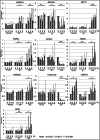Molecular karyotyping and gene expression analysis in childhood cancer patients
- PMID: 32577795
- PMCID: PMC7769790
- DOI: 10.1007/s00109-020-01937-4
Molecular karyotyping and gene expression analysis in childhood cancer patients
Erratum in
-
Correction to: Molecular karyotyping and gene expression analysis in childhood cancer patients.J Mol Med (Berl). 2020 Nov;98(11):1657. doi: 10.1007/s00109-020-01986-9. J Mol Med (Berl). 2020. PMID: 32978668 Free PMC article.
Abstract
The genetic etiology of sporadic childhood cancer cases remains unclear. We recruited a cohort of 20 patients who survived a childhood malignancy and then developed a second primary cancer (2N), and 20 carefully matched patients who survived a childhood cancer without developing a second malignancy (1N). Twenty matched cancer-free (0N) and additional 1000 (0N) GHS participants served as controls. Aiming to identify new candidate loci for cancer predisposition, we compared the genome-wide DNA copy number variations (CNV) with the RNA-expression data obtained after in vitro irradiation of primary fibroblasts. In 2N patients, we detected a total of 142 genes affected by CNV. A total of 53 genes of these were not altered in controls. Six genes (POLR3F, SEC23B, ZNF133, C16orf45, RRN3, and NTAN1) that we found to be overexpressed after irradiation were also duplicated in the genome of the 2N patients. For the 1N collective, 185 genes were affected by CNV and 38 of these genes were not altered in controls. Five genes (ZCWPW2, SYNCRIP, DHX30, DHRS4L2, and THSD1) were located in duplicated genomic regions and exhibited altered RNA expression after irradiation. One gene (ABCC6) was partially duplicated in one 1N and one 2N patient. Analysis of methylation levels of THSD1 and GSTT2 genes which were detected in duplicated regions and are frequently aberrantly methylated in cancer showed no changes in patient's fibroblasts. In summary, we describe rare and radiation-sensitive genes affected by CNV in childhood sporadic cancer cases, which may have an impact on cancer development. KEY MESSAGES: • Rare CNV's may have an impact on cancer development in sporadic, non-familial, non-syndromic childhood cancer cases. • In our cohort, each patient displayed a unique pattern of cancer-related gene CNVs, and only few cases shared similar CNV. • Genes that are transcriptionally regulated after radiation can be located in CNVs in cancer patients and controls. • THSD1 and GSTT2 methylation is not altered by CNV.
Keywords: Childhood cancer; Copy number variation; Gene expression; Primary secondary cancer; Radiation.
Conflict of interest statement
The authors declare that they have no conflict of interest.
Figures






References
-
- Kaatsch P, Reinisch I, Spix C, Berthold F, Janka-Schaub G, Mergenthaler A, Michaelis J, Blettner M. Case-control study on the therapy of childhood cancer and the occurrence of second malignant neoplasms in Germany. Cancer Causes Control. 2009;20:965–980. - PubMed
-
- Mitelman F, Johansson B, Mertens F. The impact of translocations and gene fusions on cancer causation. Nat Rev Cancer. 2007;7:233–245. - PubMed
-
- Kolomietz E, Al-Maghrabi J, Brennan S, Karaskova J, Minkin S, Lipton J, Squire JA. Primary chromosomal rearrangements of leukemia are frequently accompanied by extensive submicroscopic deletions and may lead to altered prognosis. Blood. 2001;97:3581–3588. - PubMed
Publication types
MeSH terms
Substances
LinkOut - more resources
Full Text Sources
Medical

